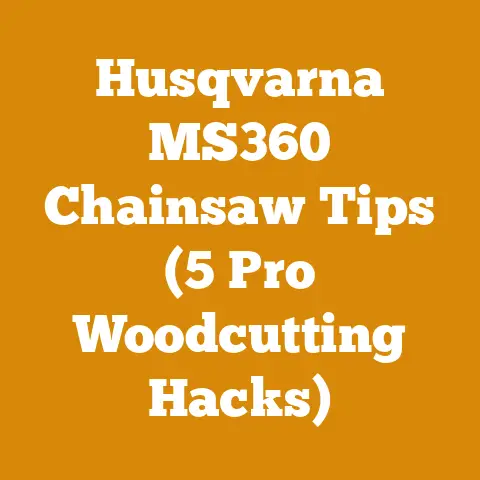How to Remove a Bush from the Ground (Expert Tips for Safe Removal)
Removing a bush might seem like a minor task, but it’s often the first step towards a bigger landscape change, a new garden bed, or even prepping land for a larger project.
It’s about clearing the way for something new, and that’s a sentiment I deeply understand.
I’ve spent years felling trees and clearing brush, not just for firewood but to reshape landscapes and make way for sustainable forestry practices.
Trust me, that initial clearing is crucial, and doing it right saves you time, effort, and potential backaches down the road.
This article is all about how to safely and effectively remove a bush from the ground, drawing on my years of experience.
How to Remove a Bush from the Ground: Expert Tips for Safe Removal
Removing a bush isn’t just about yanking it out.
It’s about understanding the root system, choosing the right tools, and employing techniques that minimize damage to your surrounding landscape.
Over the years, I’ve seen countless homeowners struggle with this task, often resorting to brute force and ending up with a half-uprooted bush and a whole lot of frustration.
Let’s avoid that, shall we?
Assessing the Situation: Before You Start Digging
Before you even think about grabbing a shovel, take a good look at the bush.
Consider these factors:
- Size and Type of Bush: A small, young bush will be much easier to remove than a mature, established one.
Different species also have different root systems.
Some have shallow, spreading roots, while others have a deep taproot.
Knowing what you’re dealing with is half the battle. - Proximity to Structures and Other Plants: Are there any underground utilities nearby?
Are there other plants you want to protect?
This will influence your approach and the tools you use.
Always call 811 (in the US) before you dig to locate underground utilities.
It’s a free service and could prevent a costly and dangerous mistake. - Soil Type: Is the soil loose and sandy, or is it compacted clay?
This will affect how easily you can dig around the roots.
I’ve worked in both extremes, and let me tell you, clay soil after a good rain is a whole different beast. - Your Physical Condition: Be honest with yourself.
Removing a bush can be strenuous work.
If you have back problems or other physical limitations, consider breaking the job into smaller chunks or enlisting help. - Time of Year: The best time to remove a bush is typically in the late fall or early spring when the plant is dormant.
This minimizes stress on the plant and makes it easier to dig around the roots.
However, you can remove a bush at any time of year if necessary.
Gathering Your Tools: The Right Equipment for the Job
Having the right tools makes all the difference. Here’s a list of essentials:
- Shovel: A sturdy, pointed shovel is your primary digging tool.
I prefer a long-handled shovel for better leverage. - Spade: A spade is useful for cutting through smaller roots and edging around the bush.
- Pruning Shears or Loppers: These are essential for cutting back branches and roots that are too thick for a spade.
- Hand Saw or Reciprocating Saw: For larger roots that are too thick for loppers, a hand saw or reciprocating saw (with a pruning blade) will be necessary.
- Pickaxe or Mattock: If you’re dealing with compacted soil or a particularly stubborn root system, a pickaxe or mattock can be a lifesaver.
- Gloves: Protect your hands from blisters and thorns. I prefer leather gloves for durability.
- Eye Protection: Safety glasses are a must to protect your eyes from flying debris.
- Wheelbarrow or Tarp: For hauling away the bush and soil.
- Root Slayer Shovel: (Optional, but Highly Recommended) This specialty shovel is designed to cut through roots with ease.
I consider it an investment well worth making if you plan on doing a lot of bush or tree removal. - High-Lift Jack and Chain (Optional): For really large and stubborn bushes, a high-lift jack and chain can provide the extra leverage you need to pull the bush out of the ground.
- Garden Hose: A garden hose with a spray nozzle can be used to wash away soil and expose the roots.
This can make it easier to identify and cut the roots.
The Step-by-Step Removal Process: Getting Down and Dirty
Now, let’s get into the nitty-gritty. Here’s a step-by-step guide to removing that bush:
- Prepare the Bush: Use pruning shears or loppers to cut back the bush to a manageable size.
This will make it easier to work around and reduce the weight you’ll be lifting.
I usually cut it back to about 1-2 feet in height. - Dig Around the Base: Using your shovel, start digging a circle around the base of the bush.
The size of the circle will depend on the size of the bush, but aim for a radius of at least 1-2 feet.
Dig down as deep as you can, trying to expose the main roots. - Identify and Cut the Roots: As you dig, you’ll encounter roots.
Use your spade, pruning shears, or saw to cut through them.
Focus on severing the larger roots first.
This is where the Root Slayer shovel really shines.
It’s designed to slice through roots with minimal effort. - Loosen the Root Ball: Once you’ve cut through most of the roots, try to loosen the root ball.
Use your shovel to pry it up from the ground.
You may need to rock the bush back and forth to loosen it completely. - Wash Away the Soil: Use a garden hose to wash away the soil from the root ball.
This will help you identify any remaining roots that need to be cut. - Remove the Bush: Once the root ball is loose and all the roots are severed, you should be able to lift the bush out of the ground.
If it’s too heavy to lift by yourself, enlist the help of a friend or use a wheelbarrow to transport it. - Fill the Hole: Fill the hole with topsoil and compost.
This will help to improve the soil and prepare it for planting something new.
Dealing with Stubborn Roots: When Brute Force Isn’t Enough
Sometimes, despite your best efforts, a bush will refuse to budge.
Here are a few tricks I’ve learned over the years for dealing with stubborn roots:
- The High-Lift Jack Method: For larger bushes with deeply entrenched roots, a high-lift jack can be a game-changer.
Dig around the base of the bush as described above.
Then, wrap a chain around the base of the bush, as close to the ground as possible.
Attach the chain to the high-lift jack and slowly begin to lift the bush.
The jack will provide tremendous leverage, allowing you to pull even the most stubborn roots out of the ground.
Be careful not to overload the jack, and always wear safety glasses. - The Water Jetting Method: If the soil is heavily compacted, it can be difficult to dig around the roots.
In this case, try using a water jetting method.
Attach a high-pressure nozzle to your garden hose and use it to blast away the soil around the roots.
This will make it easier to identify and cut the roots.
You can also rent specialized water jetting equipment from your local rental center. - The Chemical Root Killer Method: As a last resort, you can use a chemical root killer to kill the roots.
This is best done after you’ve cut back the bush to the ground.
Drill several holes into the stump and pour the root killer into the holes.
Follow the instructions on the product label carefully.
Be aware that chemical root killers can harm other plants, so use them with caution.
I generally avoid this method unless absolutely necessary, as it can have unintended consequences on the surrounding ecosystem. - The “Wait It Out” Method: If you’re not in a hurry, you can simply cut the bush back to the ground and let the roots decompose naturally.
This can take several months or even years, but it’s the most environmentally friendly option.
You can speed up the process by covering the stump with a layer of black plastic to trap heat and moisture.
Safety First: Protecting Yourself and Your Property
Removing a bush can be a dangerous task if you’re not careful.
Here are some safety precautions to keep in mind:
- Wear appropriate safety gear: This includes gloves, eye protection, and sturdy shoes.
- Call 811 before you dig: This will help you avoid hitting underground utilities.
- Be aware of your surroundings: Watch out for overhead power lines, fences, and other obstacles.
- Use caution when using power tools: Always follow the manufacturer’s instructions and wear appropriate safety gear.
- Lift with your legs, not your back: This will help you avoid back injuries.
- Take breaks when needed: Removing a bush can be strenuous work. Don’t overdo it.
- Be aware of poisonous plants: Learn to identify poisonous plants like poison ivy, poison oak, and poison sumac, and avoid contact with them.
If you do come into contact with a poisonous plant, wash the affected area immediately with soap and water.
Understanding Root Systems: A Deeper Dive
Knowing about root systems can be a game-changer.
It helps you anticipate where to dig and how much effort to expect.
- Taproot Systems: These have one main, thick root that grows straight down.
Think of a dandelion.
These are often the most challenging to remove completely. - Fibrous Root Systems: These have a dense network of smaller roots that spread out horizontally.
Grasses are a prime example.
While less deep, they can be extensive. - Spreading Root Systems: These send out horizontal roots that can sprout new plants.
Sumac and bamboo are notorious for this.
You’ll need to be vigilant to prevent regrowth. - Adventitious Roots: These roots grow from stems or leaves, not just from the base of the plant.
Ivy is a classic example.
Removal requires tracing back to the original plant.
Choosing the Right Wood: A Firewood Perspective
While you’re removing the bush, you might be wondering if the wood is good for anything.
Well, that depends on the species.
I’ve burned a lot of different types of wood in my time, and here are a few things I’ve learned:
- Hardwoods vs.
Softwoods: Hardwoods, like oak and maple, are generally denser and burn longer and hotter than softwoods, like pine and fir.
However, some softwoods, like cedar, are great for kindling. - Seasoning: No matter what type of wood you’re burning, it’s important to season it properly.
This means allowing it to dry for at least six months, preferably a year.
Seasoned wood burns more efficiently and produces less smoke. - Bush Species: Most bush species are not ideal for firewood.
They tend to be less dense and burn quickly.
However, some species, like hawthorn and certain types of maple, can be used for firewood if properly seasoned. - Safety: Never burn wood that has been treated with chemicals, such as pressure-treated lumber.
Burning treated wood can release harmful toxins into the air.
Case Study: Removing a Massive Rhododendron
I once had to remove a massive rhododendron that had taken over a corner of my property.
It was at least 10 feet tall and just as wide, with a root system that was as dense as concrete.
Here’s how I tackled it:
- Equipment Used: I used a chainsaw to cut back the branches, a Root Slayer shovel to dig around the roots, a reciprocating saw to cut through the larger roots, and a high-lift jack to pull the bush out of the ground.
- Wood Type: Rhododendron wood is not particularly good for firewood, so I chipped it and used it as mulch in my garden.
- Safety Considerations: The rhododendron was located near a power line, so I had to be extra careful when cutting back the branches.
I also wore a hard hat and safety glasses to protect myself from falling debris. - The Process: It took me two full days to remove the rhododendron.
The most challenging part was cutting through the dense root system.
The Root Slayer shovel was a lifesaver, but I still had to use the reciprocating saw for the larger roots.
The high-lift jack was essential for pulling the bush out of the ground. - Lessons Learned: This project taught me the importance of having the right tools and taking my time.
It also reinforced the fact that even the most challenging tasks can be accomplished with patience and perseverance.
The Environmental Impact: Being a Responsible Land Steward
Removing a bush, like any land management activity, has an environmental impact.
Here are some ways to minimize your impact:
- Avoid Herbicides: As much as possible, avoid using herbicides.
There are many safer ways to kill unwanted plants. - Replant Native Species: Replace the removed bush with native plants that are beneficial to the local ecosystem.
- Compost or Mulch: Compost the removed bush material or use it as mulch in your garden.
This will help to recycle nutrients and reduce waste. - Protect Soil: Disturb the soil as little as possible to prevent erosion and loss of topsoil.
- Consider Wildlife: Be mindful of wildlife habitat. Avoid removing bushes during nesting season.
Alternative Methods: When Digging Isn’t the Answer
Sometimes, digging isn’t the best approach.
Here are a few alternative methods for removing a bush:
- Girdling: This involves cutting a ring around the trunk of the bush, removing the bark and cambium layer.
This will eventually kill the bush. - Smothering: Cover the bush with a layer of black plastic or cardboard to block sunlight and kill the plant.
- Goat Grazing: Believe it or not, goats are excellent at clearing brush.
If you have access to goats, they can quickly and efficiently remove unwanted vegetation.
Frequently Asked Questions (FAQs)
- How long does it take to remove a bush? This depends on the size and type of bush, as well as your experience and the tools you have available.
A small bush can be removed in an hour or two, while a large bush can take a full day or more. - What do I do with the stump? You can either grind the stump down with a stump grinder, let it decompose naturally, or use a chemical root killer to kill the roots.
- How do I prevent the bush from growing back? Make sure to remove as much of the root system as possible.
You can also apply a herbicide to the cut stump to prevent regrowth. - Can I transplant the bush instead of removing it? Yes, if the bush is small enough and you have a suitable location to transplant it to.
However, transplanting a bush can be stressful for the plant, so it’s important to do it properly.
Conclusion: From Bush Removal to New Beginnings
Removing a bush is more than just a chore; it’s an opportunity.
It’s a chance to reshape your landscape, create space for new growth, and maybe even learn a thing or two about the natural world.
I’ve always found a certain satisfaction in clearing the land, knowing that I’m making way for something better.
Whether you’re preparing for a new garden, clearing a path for a fence, or simply tidying up your yard, I hope this guide has given you the knowledge and confidence to tackle the task safely and effectively.
Remember to assess the situation, gather the right tools, and take your time.
And don’t be afraid to get your hands dirty!
It’s all part of the process.
Now, go forth and conquer those bushes!






